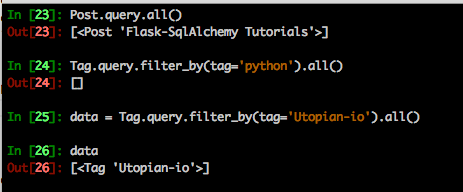What Will I Learn?
- We will learn database operations for Flask projects.
- We will learn to create relational database tables.
- We will learn to test it in the Shell environment.
Requirements
- Knowing Python
- Using Flask
- Knowing what is SQL, Relational Algebra and ORM
Difficulty
Those who are not interested in the database can be a little challenging. But overall it is basic.
Tutorial Contents
In this tutorial, I think we have a project produced for the flask. We need to store the data in this project. We will use SQLalchamy which is the most idea solution on Flask side to store this data.

Source : image
Introduction
SQLalchemy is an Object Relational Mapping library. It makes SQL expressions compatible with programming logic. It prevents long and unnecessary SQL statements from being written. Optimizes the database. It is capable of filtering, counting and bringing objects. It has many talents that we have not mentioned here. Let's go to the next step..
How to install Flask-Sqlalchemy?
- I would suggest you build it on a shell. You can skip this step.
pip install virtualenv
mkdir project_dir
virtualenv -p python3 src
source src/bin/activate
cd project_dir
- Install the flask-related setups and requirements of your project. Now install
flask-sqlalchemy.
`` pip install flask-sqlalchemy```
It will complete the process by establishing its own requirements.
Implement
from flask import Flask
from flask_sqlalchemy import SQLAlchemy
app = Flask(__name__)
.
..
#Configration
Flask offers us a great opportunity in terms of configuration. The project has the following configuration options for `flask_sqlalchemy '.
| Name | Explanation |
|---|---|
SQLALCHEMY_ECHO | SQL expressions succeed to the terminal. |
SQLALCHEMY_NATIVE_UNICODE | Sets Unicode support. |
SQLALCHEMY_DATABASE_URI | The database path is defined. |
SQLALCHEMY_BINDS | Is used to connect multiple databases. |
SQLALCHEMY_POOL_ (SIZE-TIMEOUT -RECYCLE) | Pool (size - timeout - reactivity) |
Creating a Table Class
Database tables for ORM are defined as Class. Classes can communicate with each other. Classes can be set as meta_tag to be displayed to the user or displayed to Shell. Let's examine the example below.
- Utopian Post and Tag Table :)
class Post(db.Model):
id = db.Column(db.Integer, primary_key=True)
tittle = db.Column(db.String(80), nullable=False)
body = db.Column(db.Text, nullable=False)
tag_id = db.Column(db.Integer, db.ForeignKey('tag.id'), nullable=False)
tag = db.relationship('Tag', backref=db.backref('posts', lazy=True))
def __repr__(self):
return '<Post %r>' % self.title
class Tag(db.Model):
id = db.Column(db.Integer, primary_key=True)
tag = db.Column(db.String(50), nullable=False)
def __repr__(self):
return '<Tag %r>' % self.tag
db.Model- Tables were created as inheritance.db.Column- Created Column.db.relationship- Relations set.db.backref- Users in the other table will change.
Field Types
Field types that can be used in the columns.
| Field |
|---|
Integer |
String |
Text |
Datetime |
Float |
Boolean |
Use for example : db.Integer or db.String(150)
Try shell environment
We can check how the database tables we write work in the Shell environment. It will help you understand how this web service will behave. See example usage:
- Call us first as Class. You will use this in your project. I create an object by defining the required field. We do not enter a string expression in relational tables. Be careful. We define it as an object.

- We need to save our objem in the database after we create it. If we do not do this, the data will not be saved!

- We can draw all the data on a table. We can do the filtering process. It is possible to perform complex operations.

Suggestion
Sqlalchemy users should pay attention to these.
- There may be many different solutions to what you are looking for.
- Do not query the database without saving the data. You will not have to process the updated data.
- Define the secret key and do not share it.
- Explore the database-specific SqlAlchemy configuration files you are using.
Posted on Utopian.io - Rewarding Open Source Contributors
Good job.
Downvoting a post can decrease pending rewards and make it less visible. Common reasons:
Submit
Thank you for the contribution. It has been approved.
Very interesting, I don't know much about databases, but this looks a lot better than what I'm currently using for my Flask application. Anyway a few notes about your tutorial:
You can contact us on Discord.
[utopian-moderator]
Downvoting a post can decrease pending rewards and make it less visible. Common reasons:
Submit
Thank you. I am trying to improve my English. I have pay more attention. :)
Downvoting a post can decrease pending rewards and make it less visible. Common reasons:
Submit
Thank you so much usefull
Downvoting a post can decrease pending rewards and make it less visible. Common reasons:
Submit
Hey @tolgahanuzun I am @utopian-io. I have just upvoted you!
Achievements
Suggestions
Get Noticed!
Community-Driven Witness!
I am the first and only Steem Community-Driven Witness. Participate on Discord. Lets GROW TOGETHER!
Up-vote this comment to grow my power and help Open Source contributions like this one. Want to chat? Join me on Discord https://discord.gg/Pc8HG9x
Downvoting a post can decrease pending rewards and make it less visible. Common reasons:
Submit